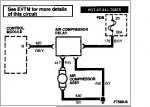sleeper
Former LOD President
Air ride light came on yesterday morning. Front end went down. Some diagnosis reveals that the compressor won't kick on. The front leaks down when the computer opens the solenoids and tries to kick on the compressor because i need to replace the o-ring on the dryer.
If I put voltage to the compressor, it kicks on.
If I connect the two big wires at the connection to the compressor relay, it kicks on.
Turn the ignition on, 90 second later the check air ride message comes on.
According to the kale mod schematics, you ground pin 18, the blue / yellow wire, to kick on the compressor. I didn't access the computer, there is a blue / yellow wire going to the relay. Normally, it has +12v. When the computer tries to kick on the compressor, it has +5v. The grey wire (the other small wire) going to the relay shows 0v. According to http://www.markviii.org/LOD2/suspension/fullsystemschematic.gif the grey wire is grounded and pin 18 is "input". According to http://www.markviii.org/LOD2/suspension/SolenoidSchematic6.gif you need to ground pin 18 to kick on the compressor (and I know this to be true from doing the kale mod on other cars). That doesn't seem to agree.
When I ground the DB/Y wire at the compressor relay, nothing happens. When I do that with the ignition on, it immediately says check air ride.
I tried swapping out the relay, didn't fix the problem.
I don't know WTF to do next.
I have a spare computer, I can try that, but i'm not too confident. I found a similar post from ponyfreak from 2003 with the same problem but no fix. He swapped the computer with no improvement.
Is there supposed to be +12v to the grey wire? That's the only thing I can think of.
If I put voltage to the compressor, it kicks on.
If I connect the two big wires at the connection to the compressor relay, it kicks on.
Turn the ignition on, 90 second later the check air ride message comes on.
According to the kale mod schematics, you ground pin 18, the blue / yellow wire, to kick on the compressor. I didn't access the computer, there is a blue / yellow wire going to the relay. Normally, it has +12v. When the computer tries to kick on the compressor, it has +5v. The grey wire (the other small wire) going to the relay shows 0v. According to http://www.markviii.org/LOD2/suspension/fullsystemschematic.gif the grey wire is grounded and pin 18 is "input". According to http://www.markviii.org/LOD2/suspension/SolenoidSchematic6.gif you need to ground pin 18 to kick on the compressor (and I know this to be true from doing the kale mod on other cars). That doesn't seem to agree.
When I ground the DB/Y wire at the compressor relay, nothing happens. When I do that with the ignition on, it immediately says check air ride.
I tried swapping out the relay, didn't fix the problem.
I don't know WTF to do next.
I have a spare computer, I can try that, but i'm not too confident. I found a similar post from ponyfreak from 2003 with the same problem but no fix. He swapped the computer with no improvement.
Is there supposed to be +12v to the grey wire? That's the only thing I can think of.


